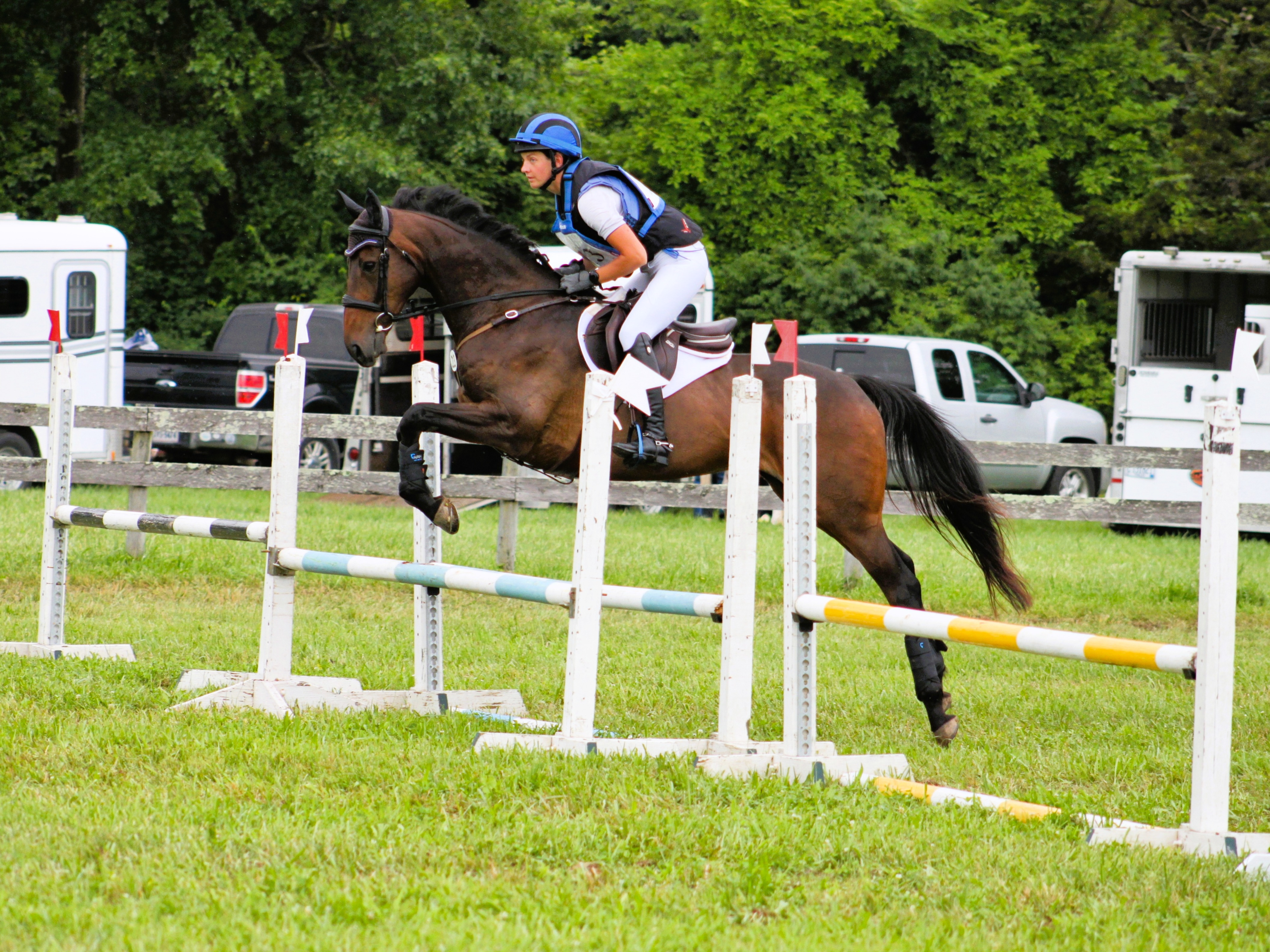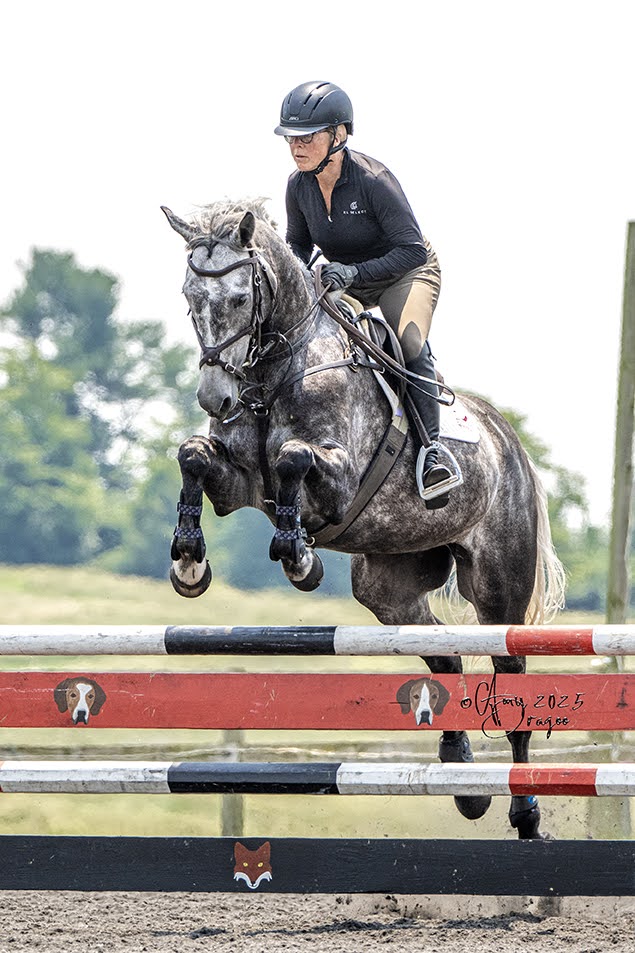
Amy Nelson and Hummingbird’s Mendacium practice transitions.
You survived No Stirrup November, the holidays are upon you, and you look to the New Year with excitement! You’re filling your 2018 calendar with horse trials and events, trying out brand new tack and show clothes from your wishlist, but do you have a plan? How can you be better this year than last?
Transitions, transitions, transitions.
The key to a responsive horse and a sophisticated hand and seat is doing 2,018 transitions as we move to the new year. Beginner students hear this all the time: it’s not the canter that’s difficult; it’s the transition. Advanced riders understand transitions get tougher as the dressage tests get harder. Medium to working to extended gaits, halt, rein-back … the list goes on. and on. In your stadium and cross country rounds you need transitions constantly. Your horse should go from a bold gallop to a coffin canter with ease. He should be able to do a working canter to cover some ground in stadium, and a more collected canter for a rollback or tight in-and-out.
He should listen to your seat and leg for a quiet downward transition — you should not rely on a heavy hand and stronger bit just to get the job done. It takes hours of practice to master transitions. What better time to practice 18 combinations of transitions, 2,018 times, than when you’re stuck inside, as the year changes?
Then you’ll be ready for spring, to go out confidently in all three phases knowing you’ll have smooth, consistent transitions.
In reality, there are probably more than 18 possible combinations. But let’s name 18 for 2018!

Photo courtesy of Amy Nelson.
1. Walk to Trot
2. Trot to Canter
3. Canter to Trot
4. Trot to Walk
5. Walk to Halt
6. Trot to Halt
7. Canter to Halt
8. Medium Trot to Working Trot
9. Working Trot to Extended Trot
10. Extended Trot to Working Trot
11. Medium Canter to Working Canter
12. Working Canter to Extended Canter
13. Medium Canter to Collected Canter
14. Medium Trot to Collected Trot
15. Gallop to Coffin Canter
16. Coffin Canter to Gallop
17. Halt to Rein-Back
18. Halt to Dismount and Take a Nap! 😉
Go from sitting to posting to two-point. And remember: It’s not your job to hold them in the perfect pace or hold them in the halt. It’s their job to do that pace or stay still until you tell them otherwise. With young Thoroughbreds we start with counting to three at the halt. Maybe we only make it to one or two. But it’s a start. Then we remind them to stop and try again; we don’t hold them in the halt. This can cause great anxiety and a young horse and lead to rearing if they feel trapped. Make it your goal throughout the winter to count to 10 or 30 or even 60 at the halt — so by spring your halt and salute at X will be no big deal!
If you’re riding a quieter, push-ride, concentrate on the upward transitions. Getting a response when you gently ask and work on more of the extended gates. This will brighten up a dull horse.
If you are on a hot, young horse, work on the downward transitions. Use mostly seat and leg and only a little bit of rein as the final message. This will help slow them be more responsive to listening for a downward transition. If you get them to the point where you can close your leg and sit on your seatbones for a halt, then in the excitement of a show you will at least get them to come back to a decent canter when you do the same.
The year is changing, and so should your gaits. Is it as fun as galloping around cross country? Of course not. But your future 2018 self will thank you for putting in all the work.
Transitions. Transitions. Transitions.









 Foxwood High: “In his five runs during the 2017 international season, ‘Woody’ finished outside the top 10 just once. His dressage scores dropped by 10 penalties from his first run of the season at The Fork to his final run at Fair Hill, where he scored in the 30s for the first time in his career. He improved his dressage score with each outing starting at Kentucky and concluding at Fair Hill. Woody also has the 3rd highest ‘clear inside the time’ rate (80%) of all 12 #ERHOTY17 nominees.”
Foxwood High: “In his five runs during the 2017 international season, ‘Woody’ finished outside the top 10 just once. His dressage scores dropped by 10 penalties from his first run of the season at The Fork to his final run at Fair Hill, where he scored in the 30s for the first time in his career. He improved his dressage score with each outing starting at Kentucky and concluding at Fair Hill. Woody also has the 3rd highest ‘clear inside the time’ rate (80%) of all 12 #ERHOTY17 nominees.” Donner: “This year Donner delivered scores in the 40s in all of his runs, the first time he has scored sub-50 in all of his tests in a single season. Donner’s 2017 dressage average of 47.5 is the best 12-month average of his international career to date. We love 100% completion rates, and Donner has now delivered 100% completion rates in seven of the eight seasons in his international career. Completing his eighth CCI4* this year is just the icing on the cake.”
Donner: “This year Donner delivered scores in the 40s in all of his runs, the first time he has scored sub-50 in all of his tests in a single season. Donner’s 2017 dressage average of 47.5 is the best 12-month average of his international career to date. We love 100% completion rates, and Donner has now delivered 100% completion rates in seven of the eight seasons in his international career. Completing his eighth CCI4* this year is just the icing on the cake.”




















